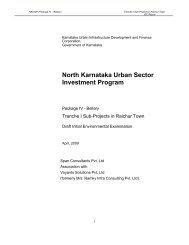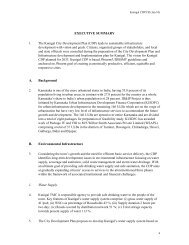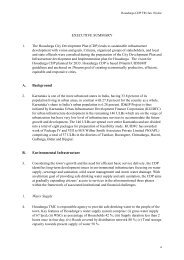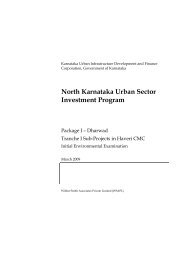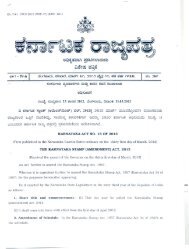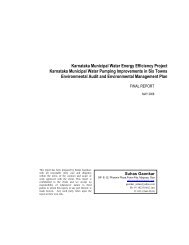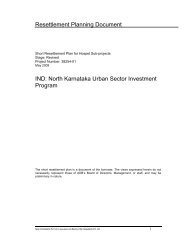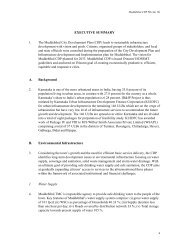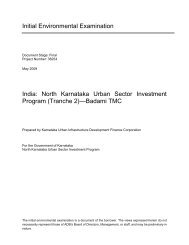Madhugiri -ES.pdf - kuidfc
Madhugiri -ES.pdf - kuidfc
Madhugiri -ES.pdf - kuidfc
Create successful ePaper yourself
Turn your PDF publications into a flip-book with our unique Google optimized e-Paper software.
<strong>Madhugiri</strong> CDP FR (Jan 10).docEXECUTIVE SUMMARY1. The <strong>Madhugiri</strong> City Development Plan (CDP) leads to sustainable infrastructuredevelopment with vision and goals. Citizens, organized groups of stakeholders, and localand state officials were consulted during the preparation of the City Development Plan andInfrastructure development and Implementation plan for <strong>Madhugiri</strong> . The vision for<strong>Madhugiri</strong> CDP planned for 2033. <strong>Madhugiri</strong> CDP is based JNnurm/UIDSSMT guidelinesand anchored on JNnurm goal of creating economically productive, efficient, equitableand responsive cities.A. Background2. Karnataka is one of the more urbanized states in India, having 33.8 percent of itspopulation living in urban areas, in contrast with 27.8 percent for the country as a whole.Karnataka’s share to India’s urban population is 6.28 percent. ID&IP Project is thusinitiated by Karnataka Urban Infrastructure Development Finance Corporation (KUIDFC)for urban infrastructure development in the remaining 146 ULBs which are on the verge ofurbanization but have very low level of infrastructure services to accommodate the futuregrowth and development. The 146 ULBs are spread over entire Karnataka and are dividedinto a total of eight packages for preparation of feasibility study. KUIDFC has awardedwork of Package IV and VIII to M/S Wilbur Smith Associates Private Limited (WSAPL)comprising a total of 37 ULBs in the districts of Tumkur, Davangere, Chitradurga, Haveri,Gulbarga, Bidar and Bijapur.B. Environmental Infrastructure3. Considering the town’s growth and the need for efficient basic service delivery, the CDPidentifies long-term development issues in environmental infrastructure focusing on watersupply, sewerage and sanitation, solid waste management and storm water drainage. Withan ultimate goal of providing safe drinking water supply and safe sanitation, the CDP aimsat gradually expanding citizens’ access to services in the aforementioned three phaseswithin the framework of associated institutional and financial challenges.1. Water Supply4. <strong>Madhugiri</strong> TMC is responsible agency to provide safe drinking water to the people of thetown. Key features of <strong>Madhugiri</strong> ‘s water supply system comprise: (i) gross water supplyof 34 lpcd; (ii) WSCs as percentage of Households 35 %; (iii) Supply duration once inthree days; (iv) Roads covered by distribution network 46 %; (v) Total storage capacitytowards present supply of water 125 %.a
<strong>Madhugiri</strong> CDP FR (Jan 10).doc5. The City Development Plan proposes to develop <strong>Madhugiri</strong> ’s water supply system basedon the following sub-project identification criteria: (i) Augmentation of water supply; (ii)New distribution network and old rehabilitation (iii) Water service connections (WSC);(iii) Metering of the system. The total cost of additional improvements in water supplysystem in the CDP period is estimated Rs. 649.42 lakhs for <strong>Madhugiri</strong> TMC.2. Sewerage and Sanitation6. <strong>Madhugiri</strong> does not have centralized sewerage system for disposal of sullage and nightsoil. The population depends largely upon individual septic tanks for their domesticwastewater disposal. The disposal of sullage and night soil is though household toilets;public toilets; and open defecation. The discharges from the septic tank are piped to theroadside open drains. At present 55 percent of property tax assessments are havingindividual toilets.7. The CDP proposes to construct new underground drainage (UGD) system with treatmentfacilities for <strong>Madhugiri</strong> town. Initially, sewerage system will be provided in the denselypopulated areas of the city where the volume of sewage generation is such that it generatessufficient self-cleansing velocity. The initial phase will be focussed on those municipalwards and adjoining areas where the population density is more than 10,000 persons persq.km., which is mostly the central part of the town. The initial phase will cover 60 percentof the households/ population, which is occupying around 20 percent of the Municipalarea. During Phase II, another 10 percent population will be added; and remainingpopulation in Phase III. Hence the sewerage system will be increased gradually to cover80 percent of households by end of CDP period (2033). The ultimate system will have 31km of sewer network and 2.80 MLD capacity treatment plant. The total investment forsewerage and sanitation sector to meet the ultimate demand of 2033 is estimated at Rs.1,255.12 lakhs.3. Storm Water Drainage8. There are two major natural drains flow through the town; from south to north and cutsSH-58 perpendicularly. The major open storm water drain is 10.8 km long and empties inthe tank located north of the town. The total length of road side drains is 35.5 km, whichcovers 91 percent of the total road length.9. The City Development Plan proposes to develop <strong>Madhugiri</strong> ’s storm water drainage basedon the below mentioned sub-project identification criteria: (i) Rehabilitation of ExistingDrains & Major Drains; and (ii) Laying of new roadside drains. The total investment instorm water drainage sector to meet the ultimate demand of 2033 is estimated as Rs.952.00 lakhs4. Solid Waste Management10. Key issues associated with <strong>Madhugiri</strong> ’s solid waste management comprise: (i) 73 percentb
<strong>Madhugiri</strong> CDP FR (Jan 10).docof waste collected from various waste generation sources; (ii) No practices of door-to-doorsegregated waste collection and lack of public awareness on SWM; and (iii) No treatmentof waste at the disposal site.11. The City Development Plan proposes to develop <strong>Madhugiri</strong> ’s SWM system based on thebelow mentioned sub-project identification criteria: (i) Developing a 100 percent door-todoorcollection system; (ii) Street sweeping; (iii) Waste collection from bulk generators;(iv) Temporary Waste Storage; (v) Purchasing of suitable vehicles and equipment (v)Waste Transportation from Containers to Disposal Site; and (vi) Waste Processing andDisposal. The total investment for solid waste management sector to meet the ultimatedemand of 2033 is estimated as Rs. 742.5 lakhs5. Traffic and Transportation12. Key transportation issues in <strong>Madhugiri</strong> TMC – (i) Poor condition of surface exhibitsdistress with cracks, potholes, raveling and soil on the surface; absence of road side drains.Condition of SH roads is poor; (ii) Soil strata of the town is characterised Gravel and thetown also has extreme climatic conditions; (iii) No traffic management; poor trafficregulation on roads and at junctions; (iv) There are two junctions and one main road withconsiderable pedestrian movement, but there is no footpath. Effective road width isreduced due to pedestrian movement on carriageway causing accidental risk; (v)Encroachment of sidewalks by street-side vendors; and (vi) There is no parking regulation;vehicles are mainly parked along the roads and junctions disturbing the traffic movement;The total investment required over the CDP period is Rs. 3,172.6 lakhs. Of the total 52percent will be utilized in Phase I and II of CDP.6. Social Infrastructure13. For improving “quality of life”, the CDP lays emphasis on developing SocialInfrastructure comprising health and education, leisure and sports, and art, culture andheritage. In view of <strong>Madhugiri</strong> ’s key issues are noticed as (i) Lack of or minimalcoordination between <strong>Madhugiri</strong> TMC and the State Government in provision andimprovement of health and education facilities; (ii) Though, fire station is located in<strong>Madhugiri</strong> TMC, it caters to the entire <strong>Madhugiri</strong> and Koratagere taluks. Existing staff,vehicles and equipments are inadequate to take of fire and emergency risks in urban aswell as rural areas; (iii) Lack of efforts to improve overall urban environment throughplanting of trees, provision of street furniture, developing of parks and playgrounds, lakedevelopment and development of leisure places etc. (iv) Lack of facilities such asswimming pool, sports complex etc. and (v) Lack of adequate and decentralized marketplaces.14. Sub-project identification is governed by the following factors: (i) Lake Restoration; (ii)Parks, Playgrounds and Sports Facilities; (iii) Crematorium Facilities (iv) Fire andEmergency Services (v) Art, Culture and Heritage; and (iv) Markets. The total investmentrequired for improvement of social infrastructure is Rs. 414 lakhs.c
<strong>Madhugiri</strong> CDP FR (Jan 10).doc7. Community Upgrading15. Issues related to basic services for the poor are dealt with in depth in the section oncommunity upgrading. Population in declared slums is 7,704 constituting about 29 percentof the total population (2008) in <strong>Madhugiri</strong> TMC. The CDP goes beyond the typical planof providing infrastructure services/community services and deals substantially on issuesrelated to livelihood promotion. While the CDP does address the larger issue of providingthe poor with access to basic services and improving the quality of life, it also deals on theinstitutional mechanism to develop a long-term program addressing livelihood promotionthrough actions like employment generation training centres, and facilitating microenterprises,among others.16. The City Development Plan proposes to develop <strong>Madhugiri</strong> as “Slum Free” based on thebelow mentioned sub-project identification criteria: (i) Provision of Pucca Houses; (ii)Slum Urgradation/Networking Projects; (iii) Construction of CommunityToilets/Convenience; (iv) Construction of Night Shelter; (v) Construction of TrainingCentres/Community Halls; and (vi) Strengthening of SJSRY Programme. The totalinvestment required for improvement of slums and urban poor is Rs. 1,300 lakhs whichwill be utilized in initial 10 years (Phase I and Phase II) to achieve the CDP goal of<strong>Madhugiri</strong> to be zero slum town by 2018.8. Urban Governance17. To ensure that the CDP is effective in meeting its goals and objectives, urban governance,and financial management issues were identified as cross-cutting issues. Service deliveryis directly linked with the institutional capacity and management. Hence key issues ininstitutional strengthening for implementation of ID&IP Project can be: (i) Vacant posts oftechnical staff affecting service delivery and O&M; (ii) Inadequate technical qualificationsor up-to-date knowledge to oversee service delivery; (iii) Inadequate staff strength toundertake high level investment and multi-sectoral projects; (iv) Inadequate managementand accounting skills; and (v) Lack of external support and training to upgrade skills. Thestrategies are adopted to overcome urban institutional issues as: (i) Efficient utilization ofhuman resources to provide sustainable services in equitable manner to all citizens; (ii)Capacity building of technical and administrative staff; (iii) Community participation andpublic involvement; (iv) Private sector participation in service delivery; and(v) Transparency in administration, planning and implementation of the projects.C. Financial Sustainability1. Municipal Finances18. With an annual Revenue Income of Rs. 231.63 lakhs in the year 2004-05, financialmanagement and fiscal status of <strong>Madhugiri</strong> TMC indicates: (i) A common accounting andd
<strong>Madhugiri</strong> CDP FR (Jan 10).docfinancial reporting code, updated annually, with interim up-dations when required,supported with a user manual and organized training of municipal accounts staff willsubstantially streamline financial accounting and reporting; (ii) coverage of propertiesunder property tax, (iii) poor collection of water charges; (iv) unclear status on extent ofoutstanding taxes and charges collectable; (v) extent of gap between the cost of serviceprovided and user charges levied; (vi) most of the revenue expenditure is accounted for byestablishment item heads, (vii) an efficient system of costing to enable the actual cost ofservices provided in a scientific manner thus enabling logical mechanism for tariffstructuring (viii) the absence of information with regard to actual assets and liabilities of<strong>Madhugiri</strong> TMC at a particular point of time render it difficult to ascertain the actual fiscalposition; and (ix) inability to capitalize on property tax revenues indicates overdependency on revenue grants and a level of complacency regarding other revenue incomesources.2. CDP Sustainability19. Financial sustainability addresses taxation and tariff reforms laid out in the assumption ofFOP. <strong>Madhugiri</strong> TMC Revenue Account and sub-project cash flows take cognizance ofpolicy directives undertaken by <strong>Madhugiri</strong> TMC in addressing infrastructure development& investment plan and sustenance needs – the focus is on property taxation, water,sewer/drainage and conservancy charges. The CDP recognizes the fact that property taxespay for capital investments and user charges pay for system operation and maintenance –given the aforesaid approach, the financial sustainability analysis focuses on reviewing netcash flows arising out of taxation and tariff reforms.20. The Financial and Operating Plan (FOP) lays out the planned fiscal status of <strong>Madhugiri</strong>TMC over the CDP period, taking cognizance of Multi-year Investment Plans for eachsub-project, sources and disposition of sub-project funds, and performance of <strong>Madhugiri</strong>TMC Revenue Account. The FOP will be reviewed annually to determine the extent towhich targets are met and undertake corrections / revisions accordingly. The FOP alsohelps in assessing the requirement of funds over the short-term and identifying sourceswith potential for revenue enhancement. The main objective of the FOP is to enable<strong>Madhugiri</strong> TMC determine their own priority objectives in terms of goals, resources,service and management aspects in the medium-term.(i)Business as usual. In this scenario, the finances of <strong>Madhugiri</strong> TMC are forecast in a“do nothing” or “without CDP” scenario. The revenue surplus thus generatedindicates <strong>Madhugiri</strong> capacity to service capital expenditure.(ii)Improved Scenario. The improvement scenario is based on investments identifiedunder the CDP and requirement for upgrading the town’s infrastructure is estimatedand phased based on construction activity. Implications of this investment in termsof external borrowings required, resultant debt service commitment, and additionaloperation and maintenance expenditure are worked out to ascertain sub-project cashflows. Revenue surpluses from the Business as usual Scenario are applied to subprojectcash flows emerging from implementable investments – the municipal fundnet surpluses indicates <strong>Madhugiri</strong>’s ability to sustain full investments. FY 2023 ise
<strong>Madhugiri</strong> CDP FR (Jan 10).docassumed as the reference year to determine the net surpluses and whether <strong>Madhugiri</strong>TMC maintain a debt/revenue surplus ratio as an indication of the <strong>Madhugiri</strong> ’sability to sustain investments.(iii)Most Optimistic Scenario. This scenario is same as improved scenario and Furtherimprovement in efficiency and tariff rationalization so that along with O&M costrecovery, some percentage of capital cost is also recovered.21. Sustainable investment for the period 2008-23 is Rs. 14.09 Crores in the improvedscenario. CDP sustainability is based on three critical factors: (i) <strong>Madhugiri</strong> TMC shouldundertake assumptions proposed in the FOP; and (ii) <strong>Madhugiri</strong> TMC should undertakegovernance reforms by way of Urban Governance, Capacity Building and InstitutionalStrengthening.3. Cost Estimates and Financing Plan22. The total cost of the City Development Plan is estimated at Rs.84.86 Crores includingduties, taxes, contingencies (physical and price) and financing charges (front-end fees andcommitment charges). Base cost of sub-project components were determined based onprevailing Schedule of Rates and compared with costs of similar nature projects – wheredesigns / detailed reports were available, costs were counterchecked and incorporated intothe CDP. Physical and price contingency is applicable on works (infrastructureinvestment), price contingency is applicable on goods (institutional development /computerization), and service taxes are applicable on services (institutional development /training and accounting, and project assistance/consulting services).D. Way Forward: Key Initiatives23. Based on the consultative process held during CDP development the following keyinitiatives and focus areas will form <strong>Madhugiri</strong> ’s Vision 2023: (i) planned development ofGrowth Management and improving the safe transport facilities within the town; (ii)focusing on safe drinking water supply; ensuring safe sanitary disposal and developingUnderground Drainage System, developing a Storm Water Master Plan, introducing doorto-doormunicipal waste collection, and safe sanitary landfill; (iii) ensuring communityparticipation in infrastructure development and service delivery and enhancing livelihoodoptions for urban poor; (iv) developing the art, culture and heritage of the city, andfocusing on improving the fire and emergency services facility; (v) <strong>Madhugiri</strong> TMC staffcapacity building in project implementation; (vi) tapping potentials of own tax sources forinstitutional options in service delivery (property tax reforms) properties coverage andimproved tax collection, user charges to address in the main report, specifically focusingon recovering O&M expenditure, and annual increase/indexation in user charges (throughCDP period) and five-year revision of property tax.f



